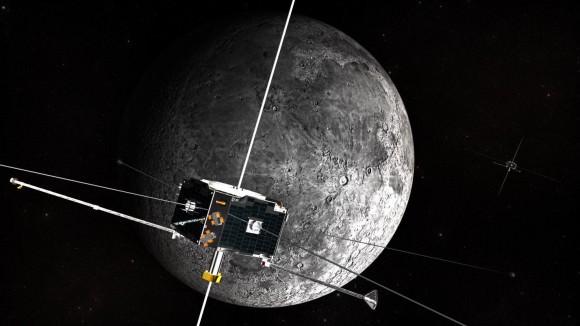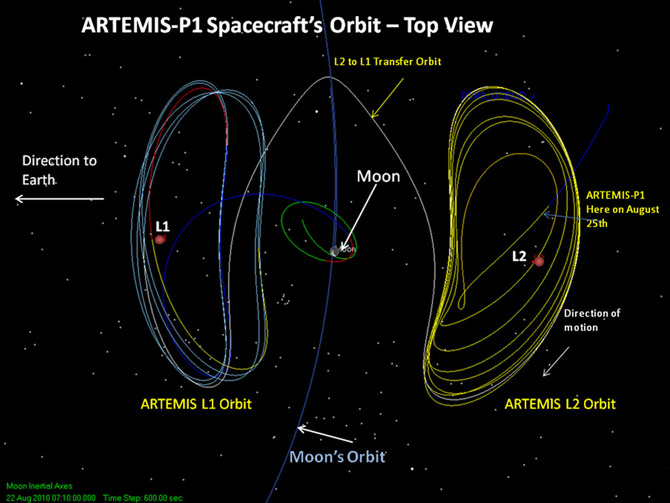[/caption]
From a Goddard Space Flight Center Press Release:
They’ve almost arrived.
It took one and a half years, over 90 orbit maneuvers, and – wonderfully – many gravitational boosts and only the barest bit of fuel to move two spacecraft from their orbit around Earth to their new home around the Moon.
Along their travels, the spacecraft have been through orbits never before attempted and made lovely curlicue leaps from one orbit to the next. This summer, the two ARTEMIS spacecraft — which began their lives as part of the five-craft THEMIS mission studying Earth’s aurora – will begin to orbit the moon instead. THEMIS is an acronym for the Time History of Events and Macroscale Interaction during Substorms spacecraft.
Even with NASA’s decades of orbital mechanics experience, this journey was no easy feat. The trip required several maneuvers never before attempted, including several months when each craft moved in a kidney-shaped path on each side of the moon around, well, nothing but a gravitational point in space marked by no physical planet or object.
“No one has ever tried this orbit before, it’s an Earth-Moon libration orbit,” says David Folta a flight dynamics engineer at NASA’s Goddard Space Flight Center in Greenbelt, Md. “It’s a very unstable orbit that requires daily attention and constant adjustments.”
The journey for ARTEMIS — short for Acceleration, Reconnection, Turbulence and Electrodynamics of the Moon’s Interaction with the Sun — began in 2009, after THEMIS had completed some two years of science data collection on the magnetic environment around Earth, the aurora, and how these are affected by the sun.
The spacecraft are solar-powered, but orbits for the two outermost THEMIS spacecraft had slipped over time and were going to be subjected to regular eight-hour periods of darkness. These spacecraft could withstand up to three hours without sunlight, but this much darkness would soon leave the batteries completely discharged.
Teams at UC-Berkeley and Goddard handled the day-to-day control of the THEMIS spacecraft. The Principal Investigator for the mission, Vassilis Angelopoulos of UCLA talked to the teams about moving the two spacecraft to the moon to study the magnetic environment there. But quick models of a conventional boost technique showed that all the remaining fuel would be used simply in transit. There wouldn’t be enough left over for the fuel-hungry process of adjusting direction and speed to actually begin circling the moon.
So Angelopoulos pulled together a new, more complex multi-year-long orbit change plan. The move would rely predominantly on gravity assists from the moon and Earth to move the spacecraft into place. He brought his idea to two engineers who had been involved with launching THEMIS in the first place: David Folta and another flight engineer at Goddard, Mark Woodard. The pair used their own models to validate this new design, and the plan was on.
First step: increase the size of the orbits. The original Earth-centric orbits barely reached half way to the moon. By using small amounts of fuel to adjust speed and direction at precise moments in the orbit, the spacecraft were catapulted farther and farther out into space. It took five such adjustments for ARTEMIS P1 and 27 for ARTEMIS P2.
Next step: make the jump from Earth orbit to the tricky kidney-shaped “Lissajous” orbit, circling what’s known as a Lagrangian point on each side of the moon. These points are the places where the forces of gravity between Earth and the moon balance each other – the point does not actually offer a physical entity to circle around. ARTEMIS P1 made the leap – in a beautiful arc under and around the moon — to the Lagrangian point on the far side of the moon on August 25, 2010. The second craft made the jump to the near side of the moon on October 22. This transfer required a complex series of maneuvers including lunar gravity assists, Earth gravity assists, and deep space maneuvers. The combination of these maneuvers was needed not only to arrive at the correct spot near the moon but also at the correct time and speed.
Using a series of Earth and moon gravity assists – and only the barest bit of fuel – the ARTEMIS spacecraft entered into orbit around the moon’s Lagrangian points in the winter of 2010. Credit: NASA Goddard Space Flight Center/Scientific Visualization Studio
History was made. Numerous satellites orbit Lagrangian points between Earth and the Sun but, while this orbit had been studied extensively, it had never before been attempted.
Not only was this an engineering feat in and of itself, but the spacecraft were now in an ideal spot to study magnetism some distance from the moon. In this position, they could spot how the solar wind – made up of ionized gas known as plasma — flows past the Moon and tries to fill in the vacuum on the other side. A task made complicated since the plasma is forced by the magnetic fields to travel along certain paths.
“It’s a veritable zoo of plasma phenomena,” says David Sibeck, the project manager for THEMIS and ARTEMIS at Goddard. “The Moon carves out a cavity in the solar wind, and then we get to watch how that fills in. It’s anything but boring. There’s microphysics and particle physics and wave particle interaction and boundaries and layers. All things we haven’t had a chance to study before in the plasma.”
Life for the flight engineers was anything but boring too. Keeping something in orbit around a spot that has little to mark it except for the balance of gravity is no simple task. The spacecraft required regular corrections to keep it on track and Folta and Woodard watched it daily.
“We would get updated orbit information around 9 a.m. every day,” says Woodard. “We’d run that through our software and get an estimate of what our next maneuver should be. We’d go back and forth with Berkeley and together we’d validate a maneuver until we knew it was going to work and keep us flying for another week.”
The team learned from experience. Slight adjustments often had bigger consequences than expected. They eventually found the optimal places where corrections seemed to require less subsequent fine-tuning. These sweet spots came whenever the spacecraft crossed an imaginary line joining Earth and the Moon, though nothing in theories had predicted such a thing.
The daily vigilance turned out to be crucial. On October 14, the P1 spacecraft orbit and attitude changed unexpectedly. The first thought was that the tracking system might have failed, but that didn’t seem to be the problem. However, the ARTEMIS team also noticed that the whole craft had begun to spin about 0.001 revolutions per minute faster. One of the instruments that measures electric fields also stopped working. Best guess? The sphere at the end of that instrument’s 82-foot boom had broken off – perhaps because it was struck by something. That sphere was just three ounces on a spacecraft that weighed nearly 190 pounds — but it adjusted ARTEMIS P1’s speed enough that had they caught the anomaly even a few days later they would have had to waste a prohibitive amount of fuel to get back on course.

As it is, ARTEMIS will make it to the moon with even more fuel than originally estimated. There will be enough fuel for orbit corrections for seven to 10 years and then enough left over to bring the two craft down to the moon.
“We are thrilled with the work of the mission planners,” says Sibeck. “They are going to get us much closer to the moon than we could have hoped. That’s crucial for providing high quality data about the moon’s interior, its surface composition, and whether there are pockets of magnetism there.”
On January 9, 2011, ARTEMIS P1 jumped over the moon and joined ARTEMIS P2 on the side of the Moon closest to Earth. Now the last steps are about to begin.
On June 27, P1 will spiral in toward the moon and enter lunar orbit. On July 17, P2 will follow. P2 will travel in the same direction with the Moon, or in prograde; P1 will travel in the opposite direction, in retrograde.
“We’ve been monitoring ARTEMIS every day and developing maneuvers every week. It’s been a challenge, but we’ve uncovered some great things,” says Folta, who will now focus his attention on other NASA flights such as the MAVEN mission to Mars that is scheduled to launch in 2013. “But soon we’ll be done with this final maneuvering and, well, we’ll be back to just being ARTEMIS consultants.”
See additional ARTEMIS imagery and video at this link.
Written by Karen C. Fox at GSFC.


Of course Congress is only gonna focus on the need for financing the science teams for another ten years now.
No thought will be paid to the enormous engineering challenge that essentially saved I don’t know how many millions of dollars’ worth of equipment.
This is a complicated orbit. The mathematics of the kidney shaped orbits around the Earth-Moon Lagrange points is somewhat involved, requiring perturbation theory according to some abstract or Lie algebra. Yet calculating the transfer orbits here must be horrific. I would imagine the work is largely numerical.
LC
I find this ridiculously impressive. I read about feats like this, or like insanely precise engineering that went into the Gravity Probe-B mission, and it makes me so sad (or furious, depending on my mood) that many of the same people crowing about “American exceptionalism” are also voraciously trying to kill the science and engineering programs like these. These are some of the most “exceptional” things humankind has ever accomplished, but the vast majority seems to prefer willful ignorance to the investment of any time learning about these things, which might inspire (challenge) them to do their own exceptional things
Sorry, I realize I’ve drifted off-topic… so, in conclusion, let me emphasize how much that first figure reminds me of some of the hardest levels of Osmos 😛
Too bad about the P1 instrument though.
Triggering my reflexive pattern search, this heuristic reminds me of this recent algorithm for heuristically solving gravitational gradient problems. Symmetry places a sweet spot of targets, which one can use repeatedly to make better targeting.
Conversely one should be able to place better target responses on a related sweet spot, at a guess. Maybe that is what they encountered. Then there may be some math to get people started on this if it isn’t solved already: “Grober’s new insight comes from a simple mathematical analysis of the problem.”
So if some are reminded of levels of Osmos, I am reminded of golf putting. =D
Too bad about the P1 instrument though.
Triggering my reflexive pattern search, this heuristic reminds me of this recent algorithm for heuristically solving gravitational gradient problems. Symmetry places a sweet spot of targets, which one can use repeatedly to make better targeting.
Conversely one should be able to place better target responses on a related sweet spot, at a guess. Maybe that is what they encountered. Then there may be some math to get people started on this if it isn’t solved already: “Grober’s new insight comes from a simple mathematical analysis of the problem.”
So if some are reminded of levels of Osmos, I am reminded of golf putting. =D
Congrats 🙂